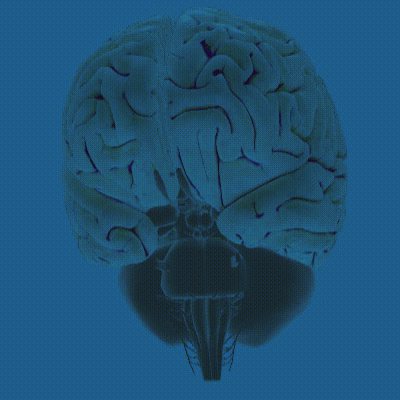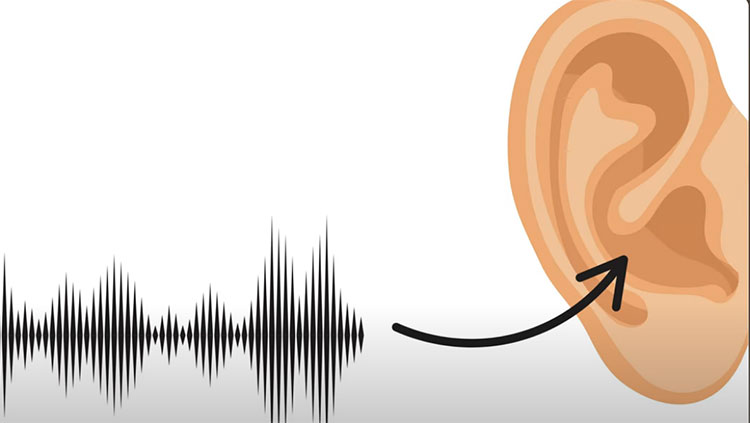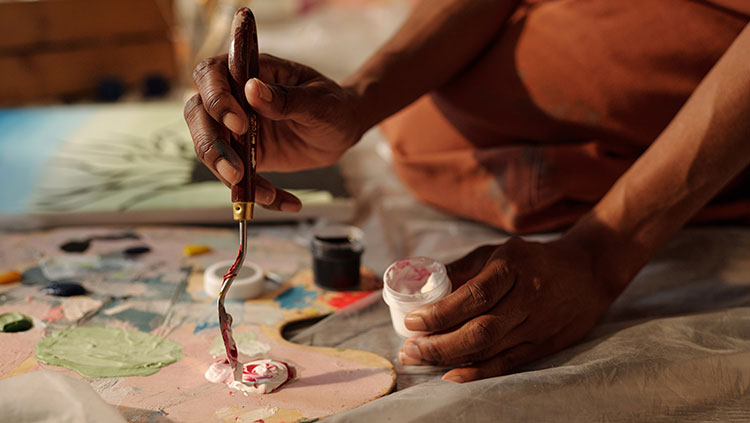Revealing the Missing Female Homunculus
- Published9 Jun 2022
- Author Zunnash Khan
- Source BrainFacts/SfN
You round the corner at the Museum of Natural History in London and stumble upon a small, ghastly human figure. It has wide eyes, huge hands and feet weighing down like rocks, and a swollen tongue sticking out through an equally swollen pair of lips. Interestingly, part of our brains think we look exactly like this.
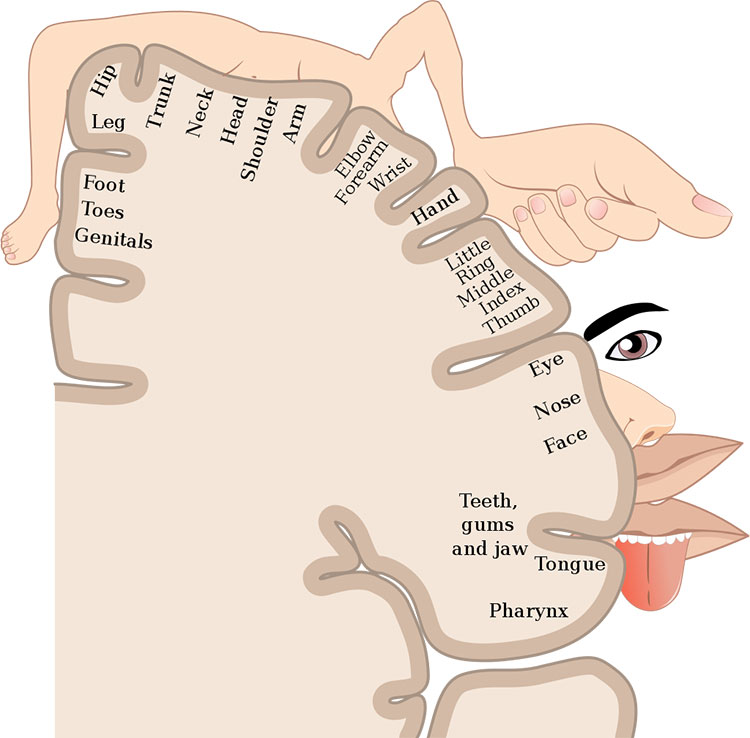
This is called the cortical homunculus. Our brains have a map of our bodies on the somatosensory cortex, a region that helps us process sensations. These sensations help us perceive things like temperature, touch, pain, and vibration. In response to these types of sensations, our bodies transmit information to regions distributed along the somatosensory cortex mapped to our body parts. However, just as females have often been underrepresented in research and clinical trials, the same omission has occurred with mapping physical sensation onto the brain.
The word homunculus means ‘little man’ in Latin. Its original concept can be linked to 16th century alchemist and physician Paracelsus, but most notably to neurosurgeon Wilder Penfield who created the first visual representations of motor and sensory mapping in the 1930s. Understanding the somatosensory homunculus has helped develop treatments for conditions like phantom pain and brain tumors.
However, as Preston Foerder, assistant professor of psychology at the University of Tennessee at Chattanooga (UTC) often tells his students: You never see a female homunculus. Haven Wright — a recent graduate of UTC and current master’s student in Art Therapy Counseling at Southern Illinois University Edwardsville — was enrolled in Foerder’s class and happened to catch his oft-used phrase during his lecture on somatic sensation. His remark stuck with her.
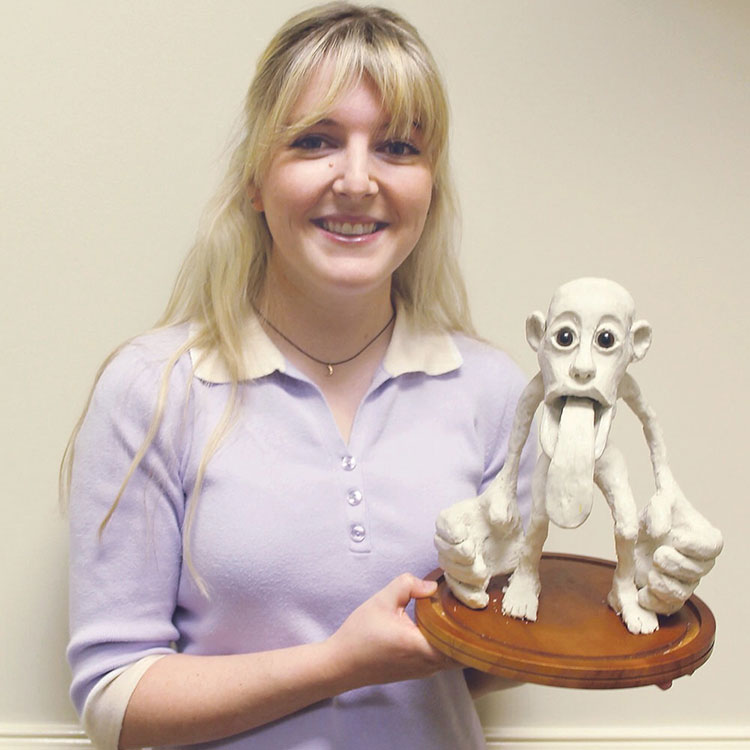
“There usually weren’t many art students that I was taking classes with when I was in the psychology department,” says Wright. “I was sitting there, and I realized ‘Oh, I’m an artist in the room here, I could do that.’” This thought kept coming back to her, and as part of Wright’s final project in the class, she created her first sculpture. Foerder recognized the importance of Wright’s work and the two teamed up.
Wright refined the sculpture, and the pair’s work resulted in the first published 3D sculpture of the female somatosensory homunculus, as reported in the science and arts journal, Leonardo, in 2021.
Remaining Knowledge Gaps
“I think female brains have been overlooked,” says Gillian Einstein, a professor of psychology at the University of Toronto. In her 2012 paper, which guided Wright’s sculpture, she and her team coined the term hermunculus — or complete map of the human female somatosensory cortex. The paper pieced together existing literature to support the beginnings of a female somatotopic map, reflective of the female body. Her team called for the research community to move beyond Penfield’s renderings and reconceptualize sensation by incorporating female-specific information — whether it’s about sexually differentiated organs, plasticity across reproductive and non-reproductive life stages, or changes that can occur after surgeries.
“Most clinical trials are done on men, and models are all male. We’re still struggling with that,” Einstein says about the somatosensory homunculus. She notes that culturally held stigmas against studying female sensation and illustrating female genitals also remain.
Penfield studied the cortices of his epileptic patients by electrically stimulating specific brain regions and asking them which part of the body they felt the resulting sensation in. His patients included both men and women; however, women only represented about 10% of the experimental population, and there was limited discussion on findings for women. Although the reason is not clear, details may have been omitted due to the of lack of conclusive data on females.
Apart from female genitalia, much of Wright’s female homunculus sculpture is proportionally equivalent to the male. Wright contributed this construction to a persisting lack of data on female somatotopic mappings, aside from genitalia.
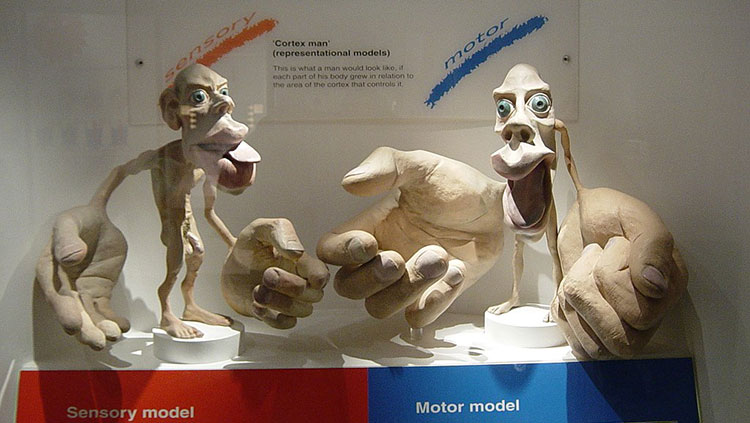
Wright’s sculpture was therefore partially guided by the London Natural History Museum’s original homunculus sculpture, existing research from Einstein and her team’s 2012 paper, and artistic illustrations done by earlier artists.
“I think it’s cool that an artist wants to represent a neuroscience question,” says Einstein. But while she appreciates it, she also points out that the sculpture isn’t much different from the male homunculus with the breasts and the vulval region attached onto it. “I think women are much more. Women deserve to be studied as women and not as men with slightly different parts.” Nonetheless, the research remains incomplete. Acknowledging this gap, Wright utilized a nondrying clay and a flexible aluminum wire frame for her model, allowing for future changes to the sculpture.
Toward a More Complete Map
Einstein explains the homunculus may also change with experience, even depending on what we do for a living. Violinists have a much larger representation of their left hands, for example, and ballet dancers would have a different somatosensory cortex than cab drivers.
A woman’s somatosensory cortex also responds to changes as her body goes through different stages of the reproductive cycle. “It would have been interesting if she’d shown a pregnant homunculus,” Einstein says. But then, she also notes that there’s still a lot of research to be done to create an accurate one.
Further investigations will need to consider different stages of female reproductive cycles to account for hormonal fluctuations in their bodies, which demands a larger study design and funding.
Wright hopes her artwork will draw attention to remaining gaps in neuroscience research and understanding. “As an artist, I would love to see my sculpture next to the one that’s been very popularized in the London Natural History Museum,” says Wright. She hopes that it will also inspire the neuroscience world to direct their efforts toward a better understanding of women.
CONTENT PROVIDED BY
BrainFacts/SfN
References
Cortical Humunculus. (April, 2022). In Wikipedia. https://en.wikipedia.org/wiki/Cortical_homunculus
Di Noto, P. M., Newman, L., Wall, S., Einstein, G. (2012). The Hermunculus: What Is Known about the Representation of the Female Body in the Brain? Cerebral Cortex, 23 (5): 1005–1013. https://doi.org/10.1093/cercor/bhs005
Gadani, A. (2015). The Femunculus [NSFW]. In Method Quarterly. http://www.methodquarterly.com/2015/02/the-femunuculs/
Holdcroft A. (2007). Gender bias in research: how does it affect evidence based medicine?. Journal of the Royal Society of Medicine, 100(1), 2–3. https://doi.org/10.1177/014107680710000102
Komisaruk, B.R., Wise N., Frangos E., Liu W., Allen, K., Brody S. (2011). Women's clitoris, vagina, and cervix mapped on the sensory cortex: fMRI evidence. Journal of Sexual Medicine. 8(10):2822-30. https://doi.org/10.1111/j.1743-6109.2011.02388.x
Nguyen, J. D. & Duong, H. (2021). Neurosurgery, Sensory Homunculus. StatPearls Publishing [Internet]. https://www.ncbi.nlm.nih.gov/books/NBK549841/
Penfield, W. & Boldrey, E. (1937). Somatic Motor and Sensory Representation in the Cerebral Cortex of Man as Studied by Electrical Stimulation. Brain, 60 (4): 389–443. https://doi.org/10.1093/brain/60.4.389
Residual Limb Pain. (2021). Mayo Foundation for Medical Education and Research. https://www.mayoclinic.org/diseases-conditions/residual-limb-pain/symptoms-causes/syc-20541403
Voll, C.S. (2021). Homunculi: Alchemists' Dream Artificial Humans. History of Yesterday. https://medium.com/@csvoll/homunculi-alchemists-dream-artificial-humans-4121b39094d3
Wright, H. & Foerder, P. (2021). The Missing Female Homunculus. Leonardo, 54 (6): 653–656. https://doi.org/10.1162/leon_a_02012
Also In The Arts & The Brain
Trending
Popular articles on BrainFacts.org


